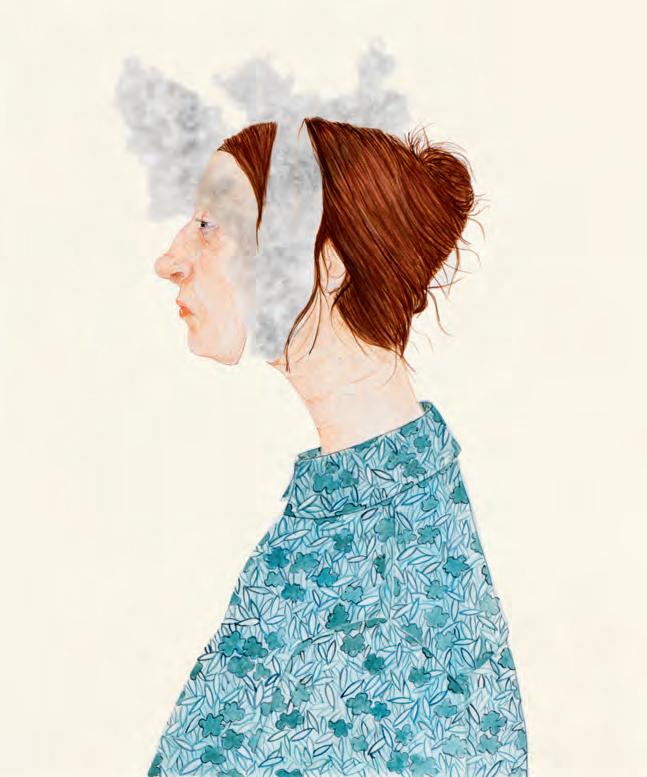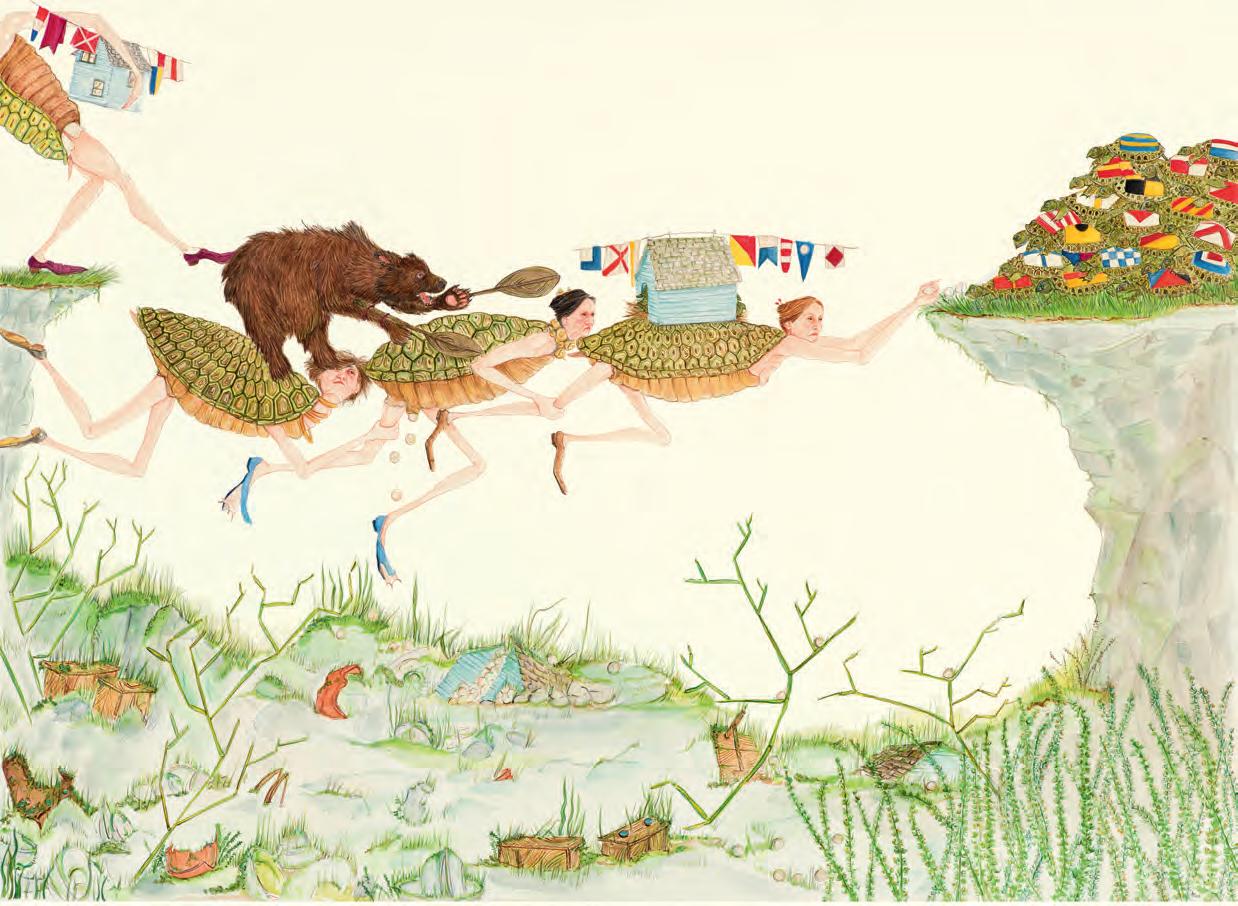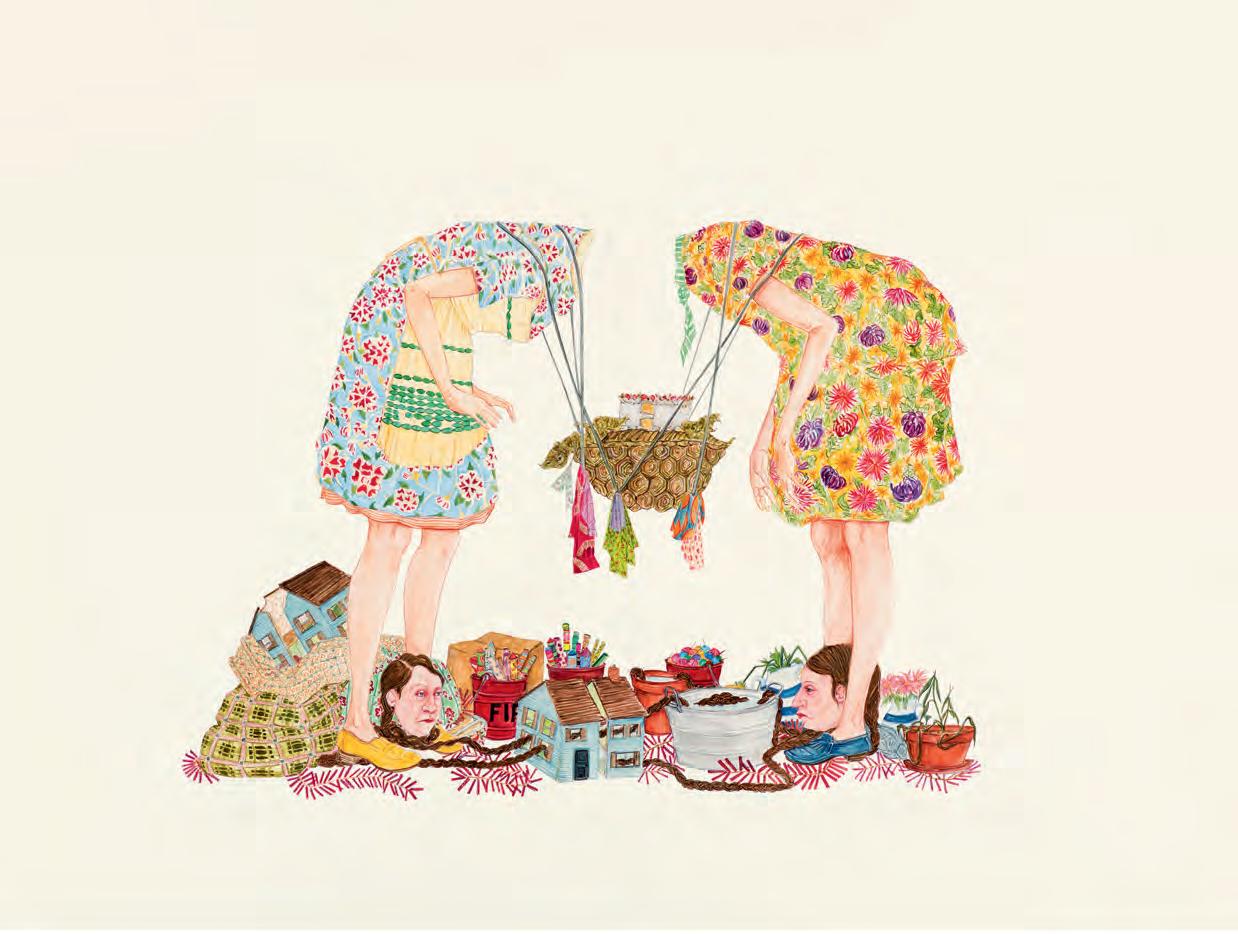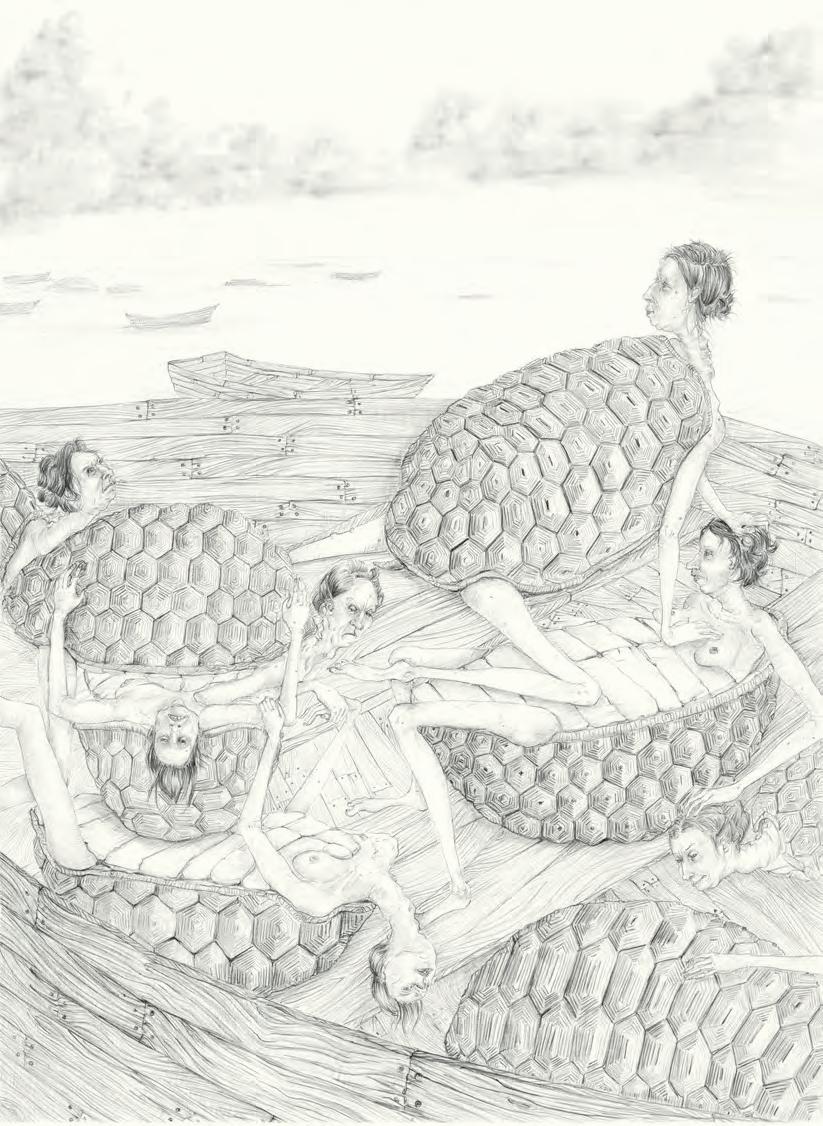

A m y C utler


A m y C utler
li m bo
D C MOOR E GALLE R Y
IN COOPERATION WITH LESLIE TONKONO W ARTWORK S + PROJECTS

A m y
Cutle
r in co n versatio n with K l au s O t t man n
Fo r m ore than t w ent y- five year s, Amy Cutler has produced enigmatic, narrative works of art in which internalized emotions, societal observations, and complex ideas are transformed into visual metaphors. Her exquisitely detailed drawings and paintings on paper, informed by Medieval paintings and manuscripts, Indian and Persian miniature paintings, Japanese woodblock prints, twentieth century photography and contemporary dance, depict anthropomorphized objects, animals, and female characters engaged in impossible tasks and unlikely situations. Her narratives, woven together from recurring figures and symbols, are often highly personal, featuring almost exclusively women, and more recently, hybrid characters melding women with animals. Her paintings and drawings alternate between the mysterious, the surreal, the ominous, and the comical, often featuring large areas of unpainted backgrounds that focus our eyes on the painted fig ures and situations and, at times, function as a visualization for water, but always prompt us to use our own imaginations.
K laus Ottmann : You have been making paintings with gouache and pencil drawings exclusively on paper. What is it that attracts you about paper?
Amy Cutler : When I was in college I painted on canvas, but switched to working on wood panels to avoid texture and the give of the surface. In 1994, I took part in an exchange program at the Städelschule in Frankfurt, Germany. Knowing that I had to bring all of my work back to the US, paper was just more practical. I had chosen to study in Germany because of my interest in medieval paintings and manuscripts. I had fallen in love with both medieval manuscripts and Persian miniatures. I began to favor matte surfaces because they absorb light instead of reflecting it. I primarily work

with gouache and graphite now. I prefer paper because of the immediacy and the way the medium is absorbed into the surface. In the past when I worked on canvas or wood, there was a sense that the images were floating and the heft of the structure worked against the delicacy of the lines.
K O : One of the things that early on attracted me to your work, and still does, is your use of white space--how the unpainted or undrawn areas of the paper really become part of the composition.
A C : The white space has evolved over time. I had been oversaturating my paintings with details, and the focus became muted and compromised. Using the white area of the paper as a compositional device brought more focus to the narrative, and as a result, the paintings became less static. The space became energized, which gave me the freedom to imagine the figures moving within space. I’m still using the white space but in different ways, for example in Steeped [p. 13] the white space becomes water. Some Japanese screens that depict the changing of seasons often use cloud cover to morph the passage of time. This might be done with gold leaf and it conceals the transitions. This creates a visual pause and transforms into something that really appeals to me, because it adds depth to the narrative by allowing the viewer to imagine what is not shown.
KO: Do you conceptualize your compositions before you put them on paper?
A C : I do a lot of thumbnail sketches before I settle on a composition. The details come later but I have the general idea of what is happening within the composition. I decide early on whether the painting will be horizontal or vertical.
KO: As you are working on completing a painting right now that you had actually started some years ago, how do you think your work has evolved over time?



A C : I’ve developed my own language based on metaphors that I have come to rely on. Having these basic building blocks helps bring forward the idea. I trust my subconscious and try not to put any restrictions on why certain images show up. My process has become more fluid. There are recurring subjects, like horses and pigs. These animals in particular have been in my work for a while. Their meaning evolves as I do. Even as a child, metaphors were always my way of dealing with bigger issues. When I was young, I didn’t have control over my environment, but I had control of my drawings. As long as I replaced people with certain animals, I could do whatever I wanted. It was a means of survival by taking back the power you don’t have. It was definitely therapeutic for me.
KO: Let’s talk more about your metaphors and the symbolism in your work. When I consider your entire body of work, it seems almost like a grand mythology is unfolding, a connected narrative of recurring themes; depictions of women (almost exclusively) interacting, or melding with animals and trees that reminds me of Ovid’s Metamorphoses
A C : I paint women very simply because I am a woman, and my work is made from my perspective.
The horse has made a reappearance in my work as something that can deliver you from one place to another. Of course normally a person would ride on the back of the horse, but my women have hitched a ride inside. In Commencement [p. 3], some of the women are inside the horses, which is an idea that I am still working through. A few years ago, I saw a photo of a cheap Dollar Store toy, where the body of the horse had been split open to reveal a doll’s head that had been repurposed and positioned so that her hair became the horse’s tail. I don’t know if this toy really existed, but I thought the idea was great. I like absurd things that make me question the validity of a scenario. I had to ask myself how her head would have gotten in there if she existed in my imaginary world. I formulated a story about

her experience inside the horse and questioned what the outcome would be. Horses appeal to me because of their strength and their ability to travel long distances. I imagine the women inside the horses are there for protection and transportation. In Narcissus [p 27 ], a woman is enrobed in the horse with her head appearing to be nestled in the hind end. I liken this to a scene from the Chronicles of Narnia: The Lion the Witch and the Wardrobe , where Edmund rifles through the wardrobe and grabs a big fur coat before he enters snowy Narnia. She is also on a journey through an unknown land. The woman is most likely part horse instead of being a passenger. The figure stands on its front hooves and very precariously peers into a pond. There’s a lot of weight placed on those hooves, but she has the strength to stand there while being bombarded by arrows. I was thinking about the plight of St. Sebastian and his association with being the patron saint of epidemics. All these things are happening at the same time, but the title Narcissus came last. The horse/woman awkwardly hovered on an empty white paper for a few years before I decided that the horse would be standing near a pond. That’s when I decided that instead of the horse seeing its reflection, it would encounter a horse’s muzzle. This alluded to another space beyond the surface of the water, adding a layer of the unknown. Sometimes I have to wait for these things to happen. After the horse’s nose emerged from the water, everything else fell into place. I saw the obvious link to the Greek myth, so the painting titled itself.
In a lot of the current work, I revisited unresolved ideas from older paintings. I trusted my subconscious and didn’t over analyze the work when I had made it, but over time I understood what they were about. I realized that I had left my characters in very bad situations, and I had the strong need to go back and rescue them. The new versions are not closely related to the first paintings, but I made sure that the characters were given the power to avoid their peril. It was good to know I was in a better place and could bring them along.



The turtles always represented slowness and the passage of time because they live so long; they are also considered to be wise. When you’re going through changes and striving for stability, a turtle can be a great metaphor for something that has everything it needs all in one place. They are protected and travel with their homes on their backs. Recently, while I was in the process of titling the work for this show, I found a turtle reference that mentioned in indigenous cultures turtles represented mother earth, feminine energy and the importance of balancing one’s inner and outer worlds.
KO: What about the pigs?
A C : The pigs originated from the time I was living in Germany. I was a vegetarian at the time, and there was so much pork being eaten. During the New Year’s celebration there were images of pigs everywhere. Marzipan pigs are eaten for good luck, and there were many pig- themed items on display in the stores. I enjoyed all the Victorian style post cards that pictured realistic images of pigs looking a bit demonic. There was nothing cute about them. They were standing on their hind legs and dancing around in a circle with four leaf clovers and wearing top hats. It was bizarre and very entertaining. I looked into how pigs were represented in other cultures. I revisited the story of the Three Little Pigs and tried to fill in the unknown details about their lives beyond the well-known tale. I trusted that there must be more than three pigs and that their world had more variety. I had a cat for twenty-one years who had a very grumpy disposition, and her personality would show up in the pigs I drew. In 2000 I made a painting titled Resnouting , where the women are redistributing pig snouts to snout- less pigs. This idea originated from dog chew treats that are available in most pet stores – bins of dried pig snouts and ears along with various cow parts. I could hold a bunch of pigs snouts in my hand and marvel at the pores and wrinkles. It’s alarming to see dismembered body parts turned into shelf stable dog treats. My response to

the situation was to create a painting where the snouts were redistributed to pigs that were missing snouts.
KO: Sometimes, your paintings can appear to be quite violent or disturbing. They remind me of the martyrdom paintings of early Christianity.
A C : The violence is more psychological than physical. I admire the paintings and stories of the lives of saints. They depict gore with no blood, like the image of Saint Lucy who holds a delicate flower comprised of a set of eyes that she gouged out of herself. The presentation of a body part on a platter is always bewildering. I became fascinated with the idea of martyrdom and how violence and self-harm are represented. In 2020 I had been working on a painting titled Reclamation where twenty-five women are carrying platters with various organs and body parts. This was right around the time that MeToo was erupting. I saw a direct correlation between the two. The female saints were being harassed and persecuted, usually by older men with power, and the only way to escape servitude and abuse was to mutilate themselves. They usually had to disfigure themselves to become undesirable. The lack of blood and gore found in these images is something I always return to. Persian miniatures also deal with bloodshed in a similar way. The violence is portrayed in a beautiful and tidy way. The splatters of blood are displayed as rhythmic droplet patterns. In Abettors [p. 5 ] there is a blue beast being tied down by anthropomorphic trees. Blood is replaced by flowers. Flowers are being forced into it’s mouth in lieu of what would have been blood.
KO: It’s beautiful And the red of the flowers is very powerful. I’m also intrigued by the umbrellas being used as arrows in Commencement .
A C : It ’s titled Commencement because something new is about to begin. The umbrellas reference a 2001 painting titled Umbridge . I was thinking about the etymology of umbrage it means offense and annoyance, as well

as shade or shadow. An umbrella protects you from rain, sun, and possibly women inside of horses falling from the sky. Arrows and umbrellas became one in the hunt or battle.
KO: Here’s a question I actually always wanted to ask you. When do you decide to do a pencil drawing rather than a painting in gouache? Is it like needing to take break from color once in a while?
A C : I decide very early on while I’m making thumbnail sketches. I like to use thinner paper when I use graphite because heavy weight paper tends to be too soft, and it affects the line quality. There are instances, like the series of drawings with open heads, when I felt very opposed to using color because mentally it did not seem accessible to me. Graphite drawings seem to enhance a somber mood, and there are some subjects that benefit from the absence of color. Drawing with graphite is a slow and meditative process for me. I use very hard leads and a lot of time is spent layering and repeating patterns. When I work with color, my mind is divided, I am thinking about color relationships and trying to balance all the textile s ’ patterns which hold equal importance to the subject matter.
K laus Ottmann is an independent curator, writer, and translator. He is the Adjunct Curator of the Collection at the Parrish Art Museum in Water Mill, NY, and Chief Curator Emeritus of The Phillips Collection in Washington, D.C. He is also the publisher and editor of Spring Publications, a small publishing press specializing in books on Jungian psychology, mythology, artist writings, and reli gion. In 2016, Dr. Ottmann was conferred the insignia of chevalier of France’s Order of Arts and Letters by the French ministry of culture and communication.





Amy Cutle r’s pai nting s, drawing s, an d sculptures present mysterious worlds composed of allegory, memory, and social com mentary. Combining sharp detail with open-ended imagery, Cutler transforms contemporary experience into other worldly narratives.
Cutler received her BFA from The Cooper Union School of Art in 1997 Her first solo museum show took place in 2002 at the Institute of Contemporary Art in Philadelphia, PA , and was followed by one-person exhibitions at institutions such as the Indianapolis Museum of Art , IA , the Kemper Museum of Contemporary Art, Kansas City, MO, and the Museo Nacional Centro de Arte Reina Sofía, Madrid, Spain, among many others. In 2004, her work was featured in the Whitney Biennial. She has participated in numerous major surveys of contemporary art at institutions worldwide, including the Albertina, Vienna, Austria; Brooklyn Museum, Ne w York, NY; KIASMA Museum of Contemporary Art, Helsinki, Finland; Kunsthallen Brandts, Odense, Denmark, M o MA P S 1 , Ne w York , NY; and the Museum Folkwang, Essen, Germany.
Her first major sculptural work, Alterations , was commissioned, exhibited, and acquired by the Museo Nacional Centro de Arte Reina Sofía, Madrid in 2007 . In 2014 , she was among a small group of artists invited by SITE Santa Fe to create new works to commemorate the twentieth anniversary of the institution . The resulting work, a multimedia sculptural installation entitled Fossa , was commissioned by SITE Santa Fe and exhibited there in 2015 and in New York at Leslie Tonkonow Artworks + Projects in 2016, and acquired by Ruby City, San Antonio, TX.
Recent solo exhibitions of her work have taken place at Ruby Cit y/ The Linda Pace Foundation, San Antonio , TX ( 2023 ) ; Madison Museum of Contemporary Art, Madison , WI ( 2021 ) ; Joslyn Art Museum, Omaha , NE (2020); and The Butler Gallery, Kilkenny, Ireland ( 2019 ).
Amy Cutler lives and works in Brooklyn, New York.
P ublic C ollections
AD & A M useum, U C Santa Barbara, CA
Baltimore Museum of Art, Baltimore, MD
Eskinazi Museum of Art, Bloomington, IN
Hammer Museum, Los Angeles, CA
Herbert F. Johnson Museum, Cornell University, Ithaca, NY
Indianapolis Museum of Art, Indianapolis, IN
The Menil Collection, Houston, TX
Metropolitan Museum of Art, New York, NY
Morgan Library and Museum, New York, NY
Museum of Modern Art, New York, NY
Museum of Fine Arts, Boston, MA
21 C Museum Foundation, Louisville, KY
Museo Nacional Centro de Arte Reina Sofia, Madrid
National Gallery of Art, Washington, D.C.
Nerman Museum of Contemporary Art, Overland Park, KS
New Museum, New York, NY
New York Public Library, New York, NY
Nova Southeastern University Art Museum, Fort Lauderdale, FL
Pennsylvania Academy of Fine Arts, Philadelphia, PA
Philadelphia Museum of Art, Philadelphia, PA
The Phillips Collection, Washington, D. C.
RISD Museum, Providence, RI
Ruby City, San Antonio, TX
Sheldon Museum of Art, Lincoln, NE
Smithsonian American Art Museum, Washington, D C
Toledo Art Museum, Toledo, OH
Walker Art Center, Minneapolis, MN
Weatherspoon Art Museum, Greensboro, NC
Whitney Museum of American Art, New York, NY

D C MOOR E GALLE R Y
535 West 2 2 Street Ne w Yor k Ne w Yor k 10 011
dcm o o r egaller y. com 212 . 2 4 7. 2 111
Published on the occasion of the exhibition
Amy Cutler : Limbo
DC M oore G aller y, M ay 2 – J une 1 5 , 2024
Am y Cutler is represented by DC Moore Gallery in cooperation with Leslie Tonkonow Artworks + Projects
© DC Moore Galler y, 2024
Images: © Amy Cutle r, 2024
Interview: © Klaus Ottmann and Amy Cutle r, 2024
isbn : 978-1-7367723-5-5
design : Josep h Guglietti
printing : Brilliant
photography : © Steven Bates; pp. 14 - 15, 23 - 24: © Adam Reich; p 21: © Richard Goodbody
cover : Commencemen t, 2023 (detai l) Gouache on paper, 5 4 3 4 x 60 inches
front flap : Convey, 2020 (detai l) Graphite on paper, 30 x 22 inches
back flap : Voyag e, 2021 (detai l) Graphite on paper, 16 x 2 0 inches



